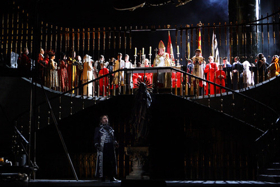Review: TOSCA, Royal Opera House

![]() Those roads that lead to Rome have brought the artist and Republican Cavaradossi, the singer Floria Tosca and the Sicilian policeman Baron Scarpia to an Eternal City whose future is in doubt. Napoleon has his eye on the seat of Europe's oldest empire as he builds his, and Naples (and all points South) suddenly looks a long way away. Scarpia, whose appetites were never far from overwhelming his political cunning, sees a last chance to sate his lust before he falls out of favour.
Those roads that lead to Rome have brought the artist and Republican Cavaradossi, the singer Floria Tosca and the Sicilian policeman Baron Scarpia to an Eternal City whose future is in doubt. Napoleon has his eye on the seat of Europe's oldest empire as he builds his, and Naples (and all points South) suddenly looks a long way away. Scarpia, whose appetites were never far from overwhelming his political cunning, sees a last chance to sate his lust before he falls out of favour.
Bryn Terfel's evil bully may be a familiar type from novels and plays, but it still jars to hear "Ha più forte sapore" lay out so explicitly both his sense of entitlement and his addiction to barely consensual sadistic sex. Terfel sneers and swaggers, but the sense of being an outsider (both in Rome and amongst these clever talented artists) never leaves him. Puccini's music rumbles in response, an uneasy peace struck between the orchestra and the singer.
Kristine Opolais moves with the grace of a ballerina, her Tosca every inch the superstar of the Roman stage. She is hilariously funny in her jealous teasing of her lover, Cavaradossi, and later than a match for Scarpia, who has played submissive games with women for so long that he cannot recognise one who will fight back. (Though why so smart a cookie failed to get the fix in with Scarpia's firing squad as insurance, seems out of character).
Vittorio Grigòlo could not be more Italian had arrived on stage in a goldola eating a gelato. His Cavaradossi is passionate, impulsive, committed and naive - an artist in every sense, and one needs a lot more than that to survive in the political turmoil of a failing state. And what a voice! (In real life, Grigòlo has been a racing driver - well, of course he has!)
Though you know it's coming (with Puccini, it's not if it's when), Opolais and Grigòlo face the hereafter with with a sensational duet, "Amaro sol per te m'era il morire", our emotions turned through the wringer yet again. It's the 509th time it's been heard at the Royal Opera House, but none of its power has diminished. So, in the battle we see between ruthless political power and romantic artistic love, who wins in the long run eh?
With all this charisma beaming forth from the principals, the minor roles have much to do to stand out, but Jonathan Lemalu delivers a fine turn as the world weary Sacristan and Hubert Francis is a sly, slimy Spoletta, Scarpia's proto-button man.
This revival of Jonathan Kent's staging delivers on the spectacle too, Paul Brown's sets and Mark Henderson's lighting capturing the otherworldliness us North Europeans feel when inside the buildings, smelling the incense and hearing the Latin of the Roman Church. The Te Deum laudamus that closes the first act, with its chorus of choirboys and priest looking down (appropriately) on Scarpia as he reflects on his diabolical plan, is an extraordinary sight.
All the while, Alexander Joel leads the orchestra, Puccini's music sometimes driving the drama, sometimes complementing it, sometimes following it, but never less than urgently glorious - violent, virtuous and valedictory. As ever with Puccini, the music feels like it was written yesterday, the intervening 119 years sliding away in the strutting confidence of his marshalling of strings, woodwind, brass and percussion. Elemental!
Three hours long, but with two intervals to recharge the emotional energy, this Tosca may not be as gruelling as some operas, but it grabs your heart from the vital opening chords and never relents. We all need a gelato to calm down by its conclusion.
Tosca continues at the Royal Opera House until 20 June.
Photo Catherine Ashmore
Videos
